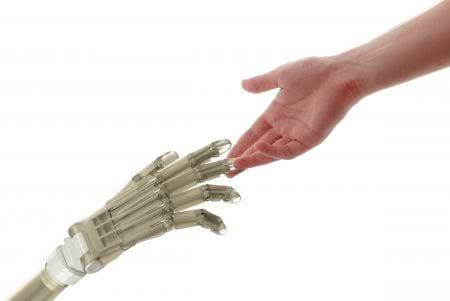A robotic sensor is, as the name suggests, a device that allows a robotic device to ‘sense’ some aspect of its environment, such as the presence of obstacles, and react accordingly. Robotic sensors can be considered the ‘eyes and ears’ of a robot. Active Robots takes A Look at Robot Sensors.
There are several different types of robotic sensor, some of which are designed to make the behaviour of a robot more ‘human’ by mimicking our own senses. All of them measure a physical quantity and convert it into a signal that the robot can understand. A combination of sensors can enable a robot to function autonomously, or independently of human control.
In the human world, we have five sensors which reflect the information we get from our world. Robot sensors are able to be programmed to get further information beyond this. Robot sensors can often see things than can move too quick for the human eye to see. Through the use of sensors, Robots have been able to perform similar tasks to human beings. There are different sensors that can be used depending on the tasks the robots need to perform. Here are examples of robot sensors and the purpose behind it.
Sound sensors, typically microphones, work on a similar principal but detect sound and generate a voltage proportional to the volume of the sound. A robot could be designed to respond to simple sounds, such as clapping of the hands, while a more sophisticated robot could be designed to respond to specific instructions given with the human voice.
Proximity sensors detect nearby objects in the environment within a certain range so that a robot can navigate around them. Some proximity sensors, known as ultrasonic sensors, emit a pulse of high frequency sound waves and analyse the echo from their surroundings for interruptions, while others, known as infrared sensors or transceivers, use invisible infrared light rather than sound waves.
Light sensors, for example, detect the presence of light and create a potential difference between two points in response. An inexpensive light sensor, known as a photoresistor, becomes less resistant electrically as the intensity of the light shining on it increases. At a more sophisticated level, such as in robots designed to identify and remove imperfect products from a conveyor, the sensor must not only detect light, but also resolve complex changing images. As such, the sensor captures an image and sends it to a computer program for analysis.
Although robots have no sight, it is possible to give robot eyes through a camera module or to integrate your robot through Camera and vision sensors. You can give your robot ‘eyes’ which allows them to recognise movements of those around it and is able to follow them.
Share with us below your favourite Robotic sensors.
A Look at Robot Sensors
Search
Recent Posts
- Phidgets VINT Hub gets a speed upgrade
- 3Pi+ Mobile Robot OLED display
- Data Acquisition and Control Hardware - a LabJack User Guide
- The all new goBILDA range, the prototyper’s favourite build system is now available in metric.
- NED Robot a NEW - low cost 6-axis Cobot for Education, Vocational training & Research laboratories
Archives
- February 2022
- December 2021
- September 2021
- March 2021
- February 2021
- January 2021
- October 2020
- March 2020
- January 2020
- December 2019
- November 2019
- June 2019
- May 2019
- April 2019
- March 2019
- February 2019
- January 2019
- November 2018
- October 2018
- September 2018
- August 2018
- July 2018
- January 2018
- November 2017
- September 2017
- August 2017
- July 2017
- January 2017
- August 2015
- May 2015
- March 2015
- February 2015
- January 2015
- December 2014
- November 2014
- October 2014
- September 2014
- August 2014
- July 2014
- June 2014
- May 2014
- April 2014
My Wish List
